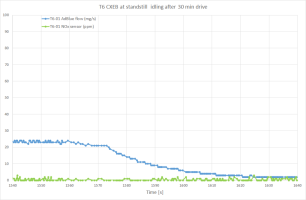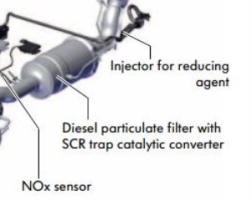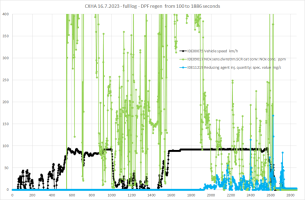You are using an out of date browser. It may not display this or other websites correctly.
You should upgrade or use an alternative browser.
You should upgrade or use an alternative browser.
AdBlue top-up issue (merge)
- Thread starter Cuiken
- Start date
-
- Tags
- adblue we connect
Yes, there can be quite a few fault code incidents before emission light threshold is reached.Im still getting the P20EE efficiency NOX fault code with out any EML
Hi hope this helps
Thanks for the log - plotted below, as well as a plot for comparison. The scaling and duration are same on the plots
GREEN = NOx level as reported by engine
BLUE = AdBlue injection amount as reported by engine

In the log the engine was idling, except revved a bit from 43...64 seconds - thus the spikes in AdBlue injection.
The confusing part is why the NOx level is so high and at the same time practically no AdBlue injection to fight the NOx.
A possibility is that when data was recorded the exhaust gases had cooled down significantly - perhaps van had been ticking over some time before logging started. The AdBlue to be effective needs exhaust gases above 200 °C. The logged temperatures were already well below.
Would be helpful if you could make a full 30 minute log - it would give "full spectrum" of AdBlue system operation. Preferably in the middle 10 minutes at steady speed of 40...60 mph. At the end two minutes ticking over.
For comparison - a log from my engine.

Thanks - a good data package. Yes, indeed the van spent quite some time doing a regen - from 100 seconds from the beginning of the log and finished off at 1886 seconds. Anyways, still leaves 16 minutes of "clean" data.Hi Mmi I've recorded more data in the middle the van decided to do a regen
A quick takeaway of the non-regen portion - compared with a log from my engine - a snippet below from here [T6_measured] NOx emissions, AdBlue consumption, DPF regeneration - Before and after ECU update
The NOx avarage was suspiciosly high 72 ppm (vs. mine 9.9 ppm).
The reported AdBlue amount 13.2 mg/s (vs. mine 15.9 mg/s) is in the right ballpark.
The data - after the regen
The high NOx up to 2000 seconds is probably remnant of the DPF regen.
Full log
Basically the section 500-2000 seconds of NOx sensor readings is typical for a non-updated T6 engine because there is no AdBlue injected during DPF regeneration (was it a software bug or designed to not to do so - probably we'll never know).
For comparison - a fairly similar runs of mine in pictures 1 and 2 here [T6_measured] NOx emissions, AdBlue consumption, DPF regeneration - Before and after ECU update
Questions:
1) Do you still get the "31103 - SCR NOx Catalyst Bank 1 - P20EE 00 [100] - Efficiency too Low" fault - as mentioned in your post on Thursday (on the log of 10th of July)
On non-updated engine software the P20EE is quite a common event - as such harmless but surely annoying.But on the 10th I did have the p20EE fault code but I cleared it and it hasn’t come back yet
Yes.I guess a software update would be a good place to start ?
Well, everything is possible. I'm afraid it's not exactly a cheap part just to try.Or could the nox sensor be faulty as it’s reading high and my not be a true reading .
However, in your last log, during DPF regeneration the sensor logged average of NOx 380 ppm - which is not far away what I had logged (423 ppm).

Certainly it's a mystery why in post #87 (log 13.7.2023) engine idling the NOx was reading high - in comparison of log 16.7.2023 engine idling after the journey almost 0 ppm (just a flip between 0 and 1 ppm).
If you mean the code for the ODIS (VW tool), no, I don't have that. Instead the actual file identifiers are the following (3771 the current software, 6168 is the update).Do you know the update code I need so I can try and get it put on but Vw want do it for me I’ll have to try else where
Welcome to VAG-Flashinfo!
VAG Flashfiles Informations - Version check of VAG ECUs - Update check for Audi, Seat, Skoda and Volkswagen
I think the way forward is to
1) update the engine software - to eliminate "false" alarms of P20EE
2) verify the actual amount injected AdBlue using either VW tester or VCDS (never verified myself this works)
3) please can you find any repair history of the van - especially if the DPF has been flushed
why?
a) Because P20EE = SCR NOx Catalyst Bank - Efficiency too Low, The NOx catalyst is part of the DPF - a porous coating in the back part of the DPF. However, with current software the fault might be also be a false one thus masking the real cause.
b) The logged differential pressure across the DPF is possibly "too" good (compared with mine with much less mileage).
That's excellent - it will be a vast improment in data logging.I’ve ordered a vcds hex v2 cable
No, for your van (150hp DSG) the software version is 6168 - to be exact software 04L 906 056 KG version 6168.Do you know what the updated software is for my van 6163 ?
Excellent!It’s turn up today
Now you can easily do full data exctract from the engine as per post#11 (link below)

AdBlue top-up issue (merge)
Leave it as it is. Don't top up. Defo don't brim it. Just carry on driving..... It will start to drop soon, in 500mile jumps. You have most likely overfilled it last time.
Whenever doing recordings please tick as below - group UDS requests by 7. It will vastly improve sampling rate - thus data recorded at significantly faster pace to catch even tiny glitches.

I’ll try and get the software updated soon asNo, for your van (150hp DSG) the software version is 6168 - to be exact software 04L 906 056 KG version 6168.
Excellent!
Now you can easily do full data exctract from the engine as per post#11 (link below)

AdBlue top-up issue (merge)
Leave it as it is. Don't top up. Defo don't brim it. Just carry on driving..... It will start to drop soon, in 500mile jumps. You have most likely overfilled it last time.www.t6forum.com
Whenever doing recordings please tick as below - group UDS requests by 7. It will vastly improve sampling rate - thus data recorded at significantly faster pace to catch even tiny glitches.
View attachment 206319
I’ll do a block map later this week as I’m back to work tomorrow on 12hr shifts
that block map it is on a hot engine ?
I’ll look into getting the DPF cleaned it can’t cost to much and maybe just worth ruling it out any way along with the software update
Actually doesn't matter cold or hot - just ignition on is good enough. Both engine (01) and Instruments (17) please.that block map it is on a hot engine ?
Please do not do anything to DPF. The DPF itself seems to work just fine.I’ll look into getting the DPF cleaned
I'm afraid that cleaning possibly ruins the NOx/SCR catalytic converter at the back of the DPF.

Similar threads
- Replies
- 13
- Views
- 2K
- Replies
- 1
- Views
- 348
- Replies
- 20
- Views
- 2K
- Replies
- 22
- Views
- 2K






